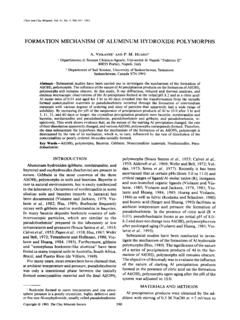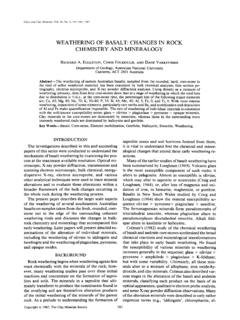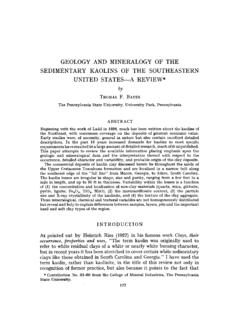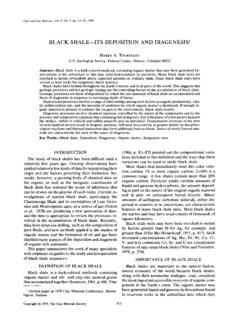Transcription of A NEW METHOD FOR THE PREDICTION OF GIBBS FREE …
1 Clays and clay Minerals, , No. 4. 459-473, 2000. A N E W M E T H O D FOR THE PREDICTION OF GIBBS FREE ENERGIES OF. formation OF hydrated clay MINERALS B A S E D ON THE. ELECTRONEGATIVITY SCALE. PHILIPPE VIEILLARD. UMR-CNRS 6532 Hydrasa, 40 Ave du Recteur Pineau. 86022 POITIERS-Cedex, France A b s t r a c t - - A new METHOD for the PREDICTION of GIBBS free energies of formation for hydrated clay minerals is proposed based on the parameter AGO- Mz+( clay ) characterizing the oxygen affinity of the cation M ~ . The GIBBS free energy of formation from constituent oxides is considered as the sum of the products of the molar fraction of an oxygen atom bound to any two cations multiplied by the electronegativity difference defined by the A60 = MZ+( clay ) between any two consecutive cations.
2 The A60 = Mz+( clay ). value, using a weighting scheme involving the electronegativity of a cation in a specific site (interlayer, octahedral, or tetrahedral) is assumed to be constant and can be calculated by minimization of the dif- ference between experimental GIBBS free energies (determined from solubility measurements) and cal- culated GIBBS free energies of formation from constituent oxides. Results indicate that this PREDICTION METHOD compared to other determinations, gives values within of the experimentally estimated values. The relationships between A c t - Mz+( clay ) corresponding to the electronegativity of a cation in either interlayer or octahedral sites and known A c t - Mz+(aq) were determined, thereby allowing the PREDICTION of the electronegativity of transition metal ions and trivalent ions in hydrated interlayer sites and octahedral sites.
3 PREDICTION of GIBBS free energies of formation of any clay mineral with various ions located in the interlayer and with different cations in octahedral sites is possible. Examples are given for Al-rich montmorillonite from Aberdeen, transition element-exchanged montmorillonite, and Ni-rich stev- ensite, and the results appear excellent when compared to experimental values. Key Words~Beidellite, Exchangeable Cations, GIBBS Free Energies of formation , Hectorite, Hydration, Illite, Montmorillonite, Nontronite, Saponite, Sauconite, Stevensite, Vermiculite. INTRODUCTION terizing the c a t i o n in the o c t a h e d r a l site. F o r o n e g i v e n e x c h a n g e a b l e cation, a clay m i n e r a l o f a c o m p l e x clay m i n e r a l s s u c h as smectite, v e r m i c u l i t e , illite, c o m p o s i t i o n is c o n s i d e r e d as a n ideal solid s o l u t i o n o f celadonite, m o n t m o r i l l o n i t e , a n d beidellite are c o m - 12 e n d - m e m b e r s (four u n c h a r g e d m i n e r a l s in the series m o n l y c o n s i d e r e d to b e o f p o o r c r y s t a l l i n e quality a n d talc-minnesotaite-pyrophyllite-Fe3 pyrophyllite, o f s m a l l grain size.)
4 clay m i n e r a l s h a v e v a r i a b l e c o m - four micas, a n d four celadonites). T h e c o n t r i b u t i o n o f positions a n d interlayer sites m a y b e o c c u p i e d b y cat- e a c h e n d - m e m b e r was r e c a l c u l a t e d b y Tardy a n d D u - ions, s u c h as Li R b Cs B a 2+, Sr 2 transition m e t a l play (1992) a c c o r d i n g to the m o d e l o f Tardy a n d Fritz ions, A13+, or NH4 +. clay m i n e r a l s w h o s e G i b b s free (1981) a n d Tardy e t al. (1987). e n e r g i e s o f f o r m a t i o n are d e r i v e d directly or indirectly B y c o m p a r i n g this m e t h o d to natural clay minerals, f r o m solubility m e a s u r e m e n t s are fully h y d r a t e d e v e n s o m e F e - e n r i c h e d clays ( clay Spur, C h e t o f r o m H u a n g if H 2 0 is n o t c o n s i d e r e d w h e n e q u i l i b r i u m reactions a n d Keller, 1973; a n d idealized n o n t r o n i t e f r o m Wol- are written (Tardy e t aL, 1987).
5 In h y d r a t e d clay m i n - e r y a n d Daveler, 1992) s h o w p r e d i c t e d G i b b s free en- erals, H 2 0 m o l e c u l e s o c c u r in t w o different positions: ergies o f f o r m a t i o n t h a t are v e r y different f r o m ex- interlayer (strongly b o n d e d to interlayer cations) a n d p e r i m e n t a l values. T h e s e d i f f e r e n c e s are related to t h e interparticles (relating to p h y s i c a l properties, such as p o o r c h o i c e o f AG~ o f F e z+ a n d Fe 3+ for the p r e d i c t i o n porosity or surface tension). o f solubility p r o d u c t s o f e n d - m e m b e r s (Fe2+: - 7 8 . 9. A r e c e n t m e t h o d o f p r e d i c t i o n o f G i b b s free ener- kJ/mole, Fe3+: - 4.
6 7 kJ/mole). Values o f AG7 for aque- gies of f o r m a t i o n was m a d e for h y d r a t e d c o m p o u n d s ous ferrous a n d ferric iron f r o m P a r k e r a n d K h o d a - (Tardy a n d Duplay, 1992). T h e p r i n c i p l e is b a s e d o n k o v s k i i (1995) are u s e d here. T h e s e values e n a b l e a the following: a s s u m e that the p o o r l y c r y s t a l l i z e d clay n e w scale o f A c t = Mz+(aq) values in o c t a h e d r a l co- m i n e r a l s are fully h y d r a t e d a n d are all o f the s a m e o r d i n a t i o n to b e d e t e r m i n e d . T h i s will allow the de- particle size (but n o t the s a m e v o l u m e b e c a u s e o f var- t e r m i n a t i o n o f G i b b s free e n e r g i e s o f f o r m a t i o n o f iable a m o u n t s o f w a t e r in the interlayer o f swelling some clays m i n e r a l s c o n t a i n i n g Li a n d transition met- clays).
7 In a series o f clay m i n e r a l s o f identical layer als in o c t a h e d r a l coordination. c h a r g e a n d w i t h the s a m e tetrahedral charge, h y d r a t i o n M a t t i g o d a n d Sposito (1978) p r o p o s e d a m e t h o d o f e n e r g i e s i n c r e a s e or d e c r e a s e t o g e t h e r w i t h the p a r a m - d e t e r m i n i n g the G i b b s free e n e r g i e s o f f o r m a t i o n of eter AGO- Mz+(aq) (defined in detail b e l o w ) charac- smectites a n d clay m i n e r a l s for nine e x c h a n g e a b l e cat- Copyright 9 2000, The clay Minerals Society 459. 460 Vieillard Clays and clay Minerals Table 1. GIBBS free energies of formation of oxides and ions, and calculated parameter AG~ M~+(aq) of select cations.
8 A(;O=. Mg + xx,@ /~// ! AG~ AG~ M*+(aq) F ,Mn" /. Oxides (kJ/mole) Ions (kJ/mole) (kJ/mole) .-. ,5 / / 9 9 ,. K" ~ Cr Li20 Li + 9 ~a Na20 Na 2o K20 -322. U K Rb20 Rb + II. 18 I;_. co ". Cs20 Cs + (NH4)20 NH4 + lid g~- 'g- z,n BaO Ba z+ t SrO t Sr 2+ [a~'r-H'Cr .. CaO ~ Ca 2+ MgO M g z - -250 -150 -50 2, 50 150 250. A a O ' M (aq) (kJ/mole). FeO Fe e* - MnO ~ M n 2+ Figure i. Relationship between ( -- from Martynov CuO ~ Cu 2 and Batsanov (1980) versus A 6 0 = M z (aq). CoO Co a+ NiO ~ Ni 2~ CdO Cd 2+ tion of hydrated clay minerals based on the parameter ZnO ~ Zn 2+ ~ Fe203 Fe 3+ - A o O - M z + ( a q ) as d e f i n e d i n i t i a l l y b y T a r d y a n d G a r - Cr203 Cr 3+ r e l s ( 1 9 7 7 ).))]
9 T h e m e t h o d is e x t e n d e d to all e l e m e n t s . A1203 -- AP La203 -- La 3 - HISTORICAL DEVELOPMENT OF THE. SiO 2 SiO2~ P A R A M E T E R Ao O= M z+. H20(c) H20 liq. Both previous and proposed revisions for evaluating i Robie and H e m i n g w a y (1995). the GIBBS free energies of formation are based on the 2 Barin (I985). p a r a m e t e r A ~ O = M~+(aq). T h i s p a r a m e t e r c h a r a c t e r i z e s 3 Wilcox and Bromley (1963). a g i v e n c a t i o n M ~ a n d is d e f i n e d as t h e d i f f e r e n c e 4 Codata Key Values f o r Thermodynamics (1989). s This work. between the GIBBS free energy of formation of the cor- 6 Shock and Helgeson (1988). responding oxides [AG~MOx(c)] and the GIBBS free 7 Parker and Khodakovskii (1995).
10 Energy of formation of the corresponding aqueous cat- s Sverjensky et al. (1997). i o n [AG~Mz+(aq)]: AGO = M z + ( a q ) = ( 1 / x ) [ A G ~ M O x ( C ) -- A G ~ M z + ( a q ) ]. i o n s ( L i +, N a +, K +, R b +, C s +, M g 2+, C a 2+, S r 2+, a n d (kJ/mol) (1). Ba2 N o m e t h o d o f p r e d i c t i o n is a v a i l a b l e f o r c l a y m i n e r a l s w i t h o t h e r e x c h a n g e a b l e c a t i o n s , s u c h as w h e r e z is t h e c h a r g e o f t h e c a t i o n M z+, a n d x is t h e some transition metals and rare-earth metals. These number of oxygen atoms combined with one atom of compounds frequently occur where environmental and M in t h e o x i d e (x = z/2), s o t h a t t h e d i f f e r e n c e in waste-management problems exist.)















